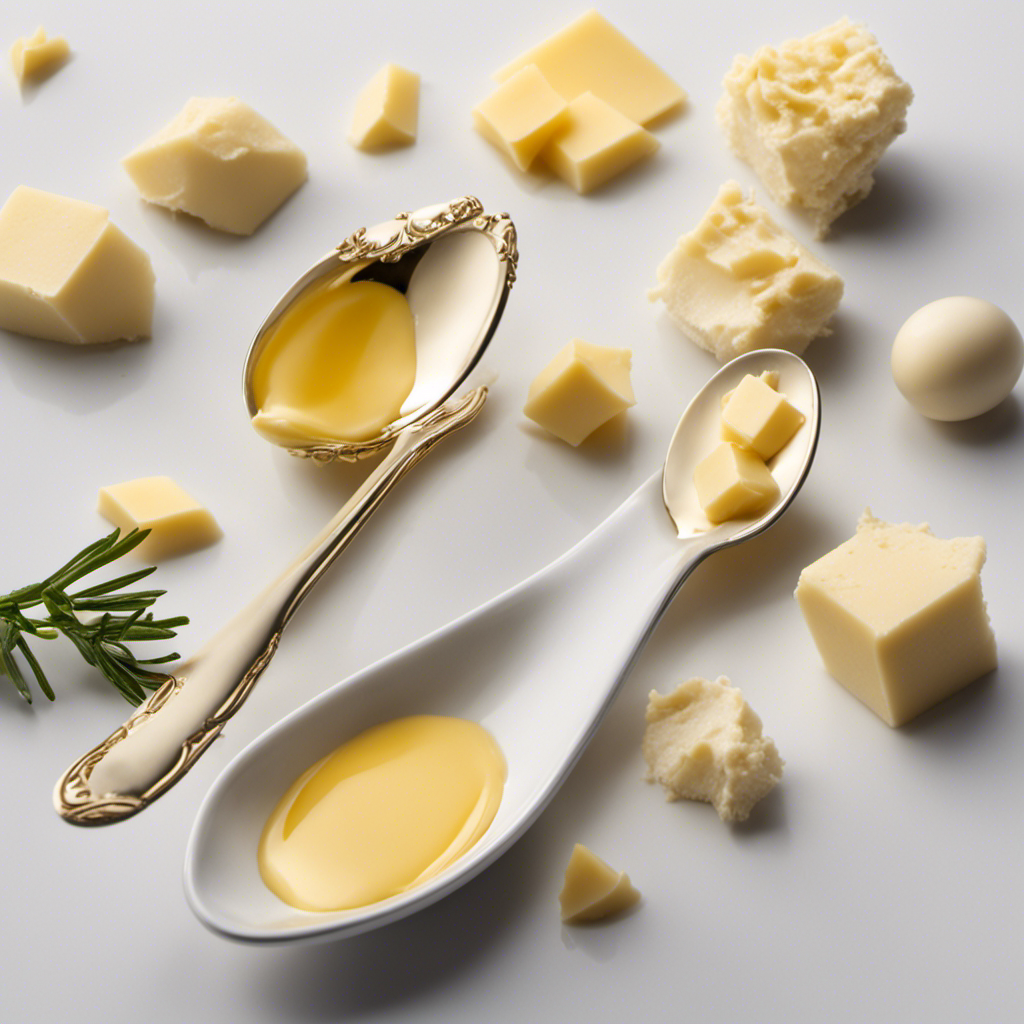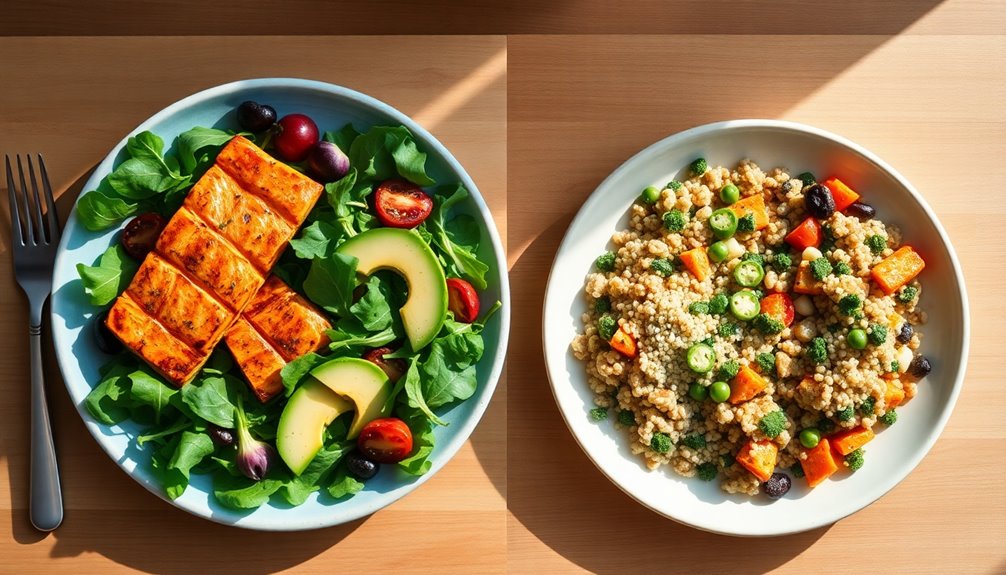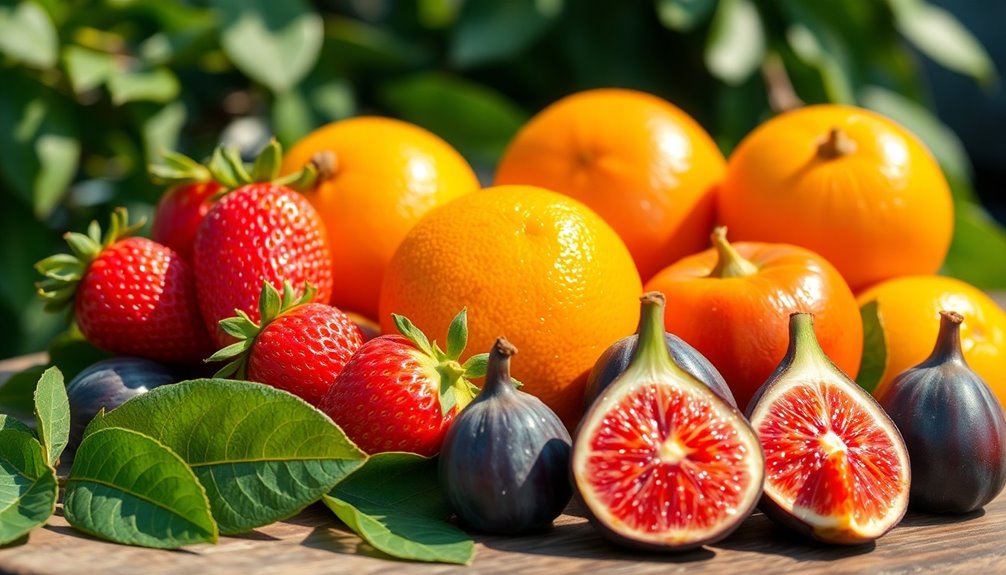The text rewritten: The famous saying goes, ‘You are what you eat.’ When it comes to monitoring calorie consumption, having knowledge is key. Let’s explore the realm of baked potatoes with butter and reveal the amount of calories hidden beneath that delicious, melt-in-your-mouth goodness.
In this article, I’ll provide you with a nutritional breakdown, explore the impact of butter on the calorie content, compare it to other toppings, offer tips for reducing calorie intake, and discuss the health benefits and drawbacks of indulging in this tasty treat.
Let’s get started!
Key Takeaways
- A baked potato with butter contains approximately 280 calories.
- Adding butter significantly increases the overall calorie content of a baked potato.
- Toppings like sour cream, cheese, and bacon can increase calorie and fat content.
- Healthier alternatives like Greek yogurt, olive oil, and steamed vegetables can be used to reduce calorie intake and enhance nutritional value.
Nutritional Profile of a Baked Potato With Butter
You’ll be glad to know that a baked potato with butter contains approximately 280 calories.
When it comes to the macronutrient breakdown of this dish, it is important to note that carbohydrates make up the majority of the calories in a baked potato. A medium-sized potato provides around 37 grams of carbohydrates, which are the primary source of energy for our bodies.
In addition to carbohydrates, a baked potato with butter also contains a small amount of fat and protein.
As for the health benefits, potatoes are rich in vitamins and minerals, such as vitamin C, potassium, and fiber. However, it’s worth mentioning that adding butter to the potato increases its calorie and fat content.
Transitioning into the subsequent section, let’s take a closer look at the overall calorie count of a baked potato with butter.
Calorie Count of a Baked Potato With Butter
When it comes to the calorie count of a baked potato with butter, it’s important to consider the contribution of the butter itself. Butter is high in fat and calories, so adding a generous amount can significantly increase the overall calorie content of the potato.
Additionally, the impact of other toppings, such as sour cream or cheese, should also be taken into account as they can add even more calories.
For those looking for healthier alternatives, swapping out butter for alternatives like Greek yogurt or olive oil can help reduce the calorie intake without sacrificing flavor.
Butter’s Calorie Contribution
The butter adds extra calories to the baked potato. While a baked potato itself is a nutritious choice, adding butter can significantly increase its calorie content. Here are three key points to consider:
-
Creamy and smooth: When melted over a hot baked potato, the butter creates a rich, velvety texture that coats every bite.
-
Golden and glistening: The butter adds a beautiful golden sheen to the potato, making it visually appealing and appetizing.
-
Flavor enhancer: The richness and subtle saltiness of the butter elevate the taste of the potato, making it even more satisfying.
Although butter can enhance the flavor and visual appeal of a baked potato, it’s important to practice portion control to manage your calorie intake. Opting for a moderate amount of butter or exploring healthier alternatives can help strike a balance between taste and nutritional value.
Impact of Toppings
Adding various toppings to a baked potato can create a delicious and satisfying meal. Not only do toppings enhance the flavor of the potato, but they also contribute to the overall nutritional value of the dish.
However, it is important to be mindful of the health risks associated with certain toppings. While toppings like sour cream, cheese, and bacon can add richness and flavor, they can also increase the calorie and fat content of the meal.
It is recommended to opt for healthier toppings such as Greek yogurt, salsa, or steamed vegetables to keep the dish nutritious. Experimenting with different toppings can still result in a tasty and enjoyable baked potato while minimizing potential health risks.
Healthier Potato Alternatives
If you’re looking for a healthier alternative to a baked potato, consider trying mashed cauliflower as a lower-calorie option. Not only is it lower in calories, but it also provides a variety of nutrients.
Here are three alternatives to butter that can elevate the flavor of your mashed cauliflower:
-
Olive oil: Drizzling some extra virgin olive oil over your mashed cauliflower adds a rich and savory taste. It contains monounsaturated fats, which are considered heart-healthy.
-
Greek yogurt: Mixing in some plain Greek yogurt can make your mashed cauliflower creamy and tangy. Greek yogurt is high in protein and probiotics, which can promote a healthy gut.
-
Herbs and spices: Adding herbs and spices like garlic, thyme, or paprika can enhance the flavor of your mashed cauliflower without adding any extra calories. Experiment with different combinations to find your favorite blend.
Macronutrient Breakdown of a Baked Potato With Butter
To determine the macronutrient breakdown of a baked potato with butter, you’ll want to consider the amount of carbohydrates, fats, and proteins present. A baked potato with butter is a popular side dish that provides both comfort and flavor. However, it is important to be mindful of portion control and consider the nutrient density of this dish. Here is a breakdown of the macronutrients found in a medium-sized baked potato with one tablespoon of butter:
| Macronutrient | Amount per Serving |
|---|---|
| Carbohydrates | 37 grams |
| Fats | 8 grams |
| Proteins | 4 grams |
While the carbohydrates in a baked potato provide energy, the fats from the butter contribute to its flavor and satiety. It is important to note that portion control is key when consuming this dish to maintain a balanced diet.
Impact of Butter on the Calorie Content of a Baked Potato
When you include butter on your baked potato, it increases the overall calorie content. Butter is high in fat, and just one tablespoon contains around 100 calories. Therefore, if you add a generous amount of butter to your baked potato, it can significantly increase its calorie count.
However, it’s important to consider the nutritional value and portion control when deciding whether to add butter to your potato. Here are some points to keep in mind:
- The creamy texture and rich flavor of butter can enhance the taste of a baked potato, making it a satisfying and indulgent option.
- Butter adds a glossy and appetizing appearance to the potato, making it more visually appealing.
- However, it’s crucial to be mindful of the portion size and balance the addition of butter with other nutritious toppings to maintain a well-rounded meal.
Comparing Calories in a Baked Potato With Butter to Other Toppings
When it comes to topping a baked potato, the debate between butter and sour cream has been ongoing. Both options offer a creamy and savory addition to the potato, but which one is better in terms of calories and nutritional value?
Additionally, cheese is often another popular choice for topping a baked potato, but how does it compare to butter in terms of calories and taste?
Let’s dive into the butter vs. sour cream and butter vs. cheese debate to see which option comes out on top.
Butter Vs. Sour Cream
Butter and sour cream are popular toppings for baked potatoes. When it comes to choosing between these two options, there are a few key differences to consider.
Sour cream: Creamy and tangy, sour cream adds a rich and flavorful element to a baked potato. It has a smooth texture and a slightly tangy taste that pairs well with the natural earthiness of the potato.
Impact of portion size: The portion size of sour cream can greatly affect the calorie content of your baked potato. It’s important to be mindful of the amount you use to avoid consuming excess calories. Opting for a smaller portion or using a lower-fat version can help reduce calorie intake.
Yogurt as an alternative: If you’re looking for a healthier option, consider using yogurt instead of sour cream. Greek yogurt, in particular, can provide a similar creamy texture with fewer calories and more protein.
Now, let’s move on to the next topic: butter vs. cheese.
Butter Vs. Cheese
When it comes to adding flavor to a baked potato, there are a few popular options to choose from. One of the most classic choices is butter. Butter adds a rich and creamy taste that pairs perfectly with the soft and fluffy texture of a baked potato.
However, it is important to consider the calorie content. Butter is high in calories and saturated fat, which can contribute to weight gain and heart disease when consumed in excess. If you’re looking for a healthier alternative, you may consider using margarine or olive oil instead.
Margarine is typically made from vegetable oils and contains less saturated fat than butter. Olive oil, on the other hand, is a heart-healthy fat that can provide a unique flavor to your baked potato. Both options can be a healthier choice compared to butter, while still adding a delicious touch to your meal.
Transitioning into the subsequent section, let’s explore some tips for reducing calorie intake when enjoying a baked potato with butter.
Tips for Reducing Calorie Intake When Enjoying a Baked Potato With Butter
One way to cut back on calorie intake while enjoying a baked potato is by opting for healthier toppings. By reducing the amount of butter and practicing portion control, you can still savor the deliciousness of a baked potato without consuming excessive calories.
Here are some tips to help you reduce the calorie content of your baked potato:
- Choose a smaller potato: Opt for a smaller-sized potato to control portion sizes and reduce overall calorie intake.
- Use less butter: Instead of slathering your potato with a large amount of butter, try using a smaller amount or opting for a healthier alternative like Greek yogurt or low-fat sour cream.
- Load up on veggies: Adding steamed or sautéed vegetables like broccoli, bell peppers, or spinach can add flavor and volume to your baked potato without adding many calories.
Health Benefits and Drawbacks of Consuming a Baked Potato With Butter
Opting for healthier toppings and practicing portion control can help reduce calorie intake when enjoying a baked potato with butter.
While a baked potato itself is a nutritious choice, adding butter can significantly increase the calorie count. It is important to be mindful of portion sizes and choose healthier alternatives to butter, such as Greek yogurt or low-fat sour cream.
Consuming excessive calories from butter can contribute to weight gain and increase the risk of developing health conditions like obesity, heart disease, and diabetes.
However, when consumed in moderation and paired with other nutrient-dense foods, a baked potato with a small amount of butter can be a part of a balanced diet. It’s all about finding the right balance and making informed choices to support overall health and well-being.
Frequently Asked Questions
Can I Substitute Butter With Other Toppings to Reduce the Calorie Content of a Baked Potato?
Yes, you can substitute butter with healthier alternatives to reduce the calorie content of a baked potato. Experiment with toppings like Greek yogurt, salsa, or herbs for added flavor without sacrificing taste.
What Is the Recommended Portion Size for a Baked Potato With Butter?
The recommended portion size for a baked potato with butter depends on individual dietary needs and goals. It’s important to consider the nutritional value of the potato and balance it with other components of a healthy meal.
How Does the Cooking Method Affect the Calorie Count of a Baked Potato With Butter?
When it comes to the calorie count of a baked potato with butter, the cooking method can have an impact. Different cooking methods can affect the final calorie count, as well as using butter alternatives.
Can I Use Margarine or Other Spreads Instead of Butter to Reduce Calories?
Using margarine or other spreads instead of butter can reduce calories in a baked potato. However, it may affect the taste and texture. Experiment with different spreads to find one that suits your preferences.
Is It Healthier to Consume a Baked Potato With or Without Butter?
Without butter, a baked potato can be a healthier option. It reduces the calorie and fat content. However, if you still want the flavor, it is possible to make a low-calorie version of a baked potato with butter.
Conclusion
In conclusion, a baked potato with butter can be a delicious and satisfying choice. However, it’s important to be mindful of its calorie content, which is approximately 300-400 calories per serving. This can contribute significantly to your daily intake.
By choosing healthier toppings and practicing portion control, you can still enjoy the creamy goodness without going overboard.
Just like a beautiful sunset painting, a baked potato with butter can be a treat for the senses. But moderation is key to maintain a balanced diet.










